Sewer Cleanouts Demystified: Basement Edition
By Brian on July 25, 2025
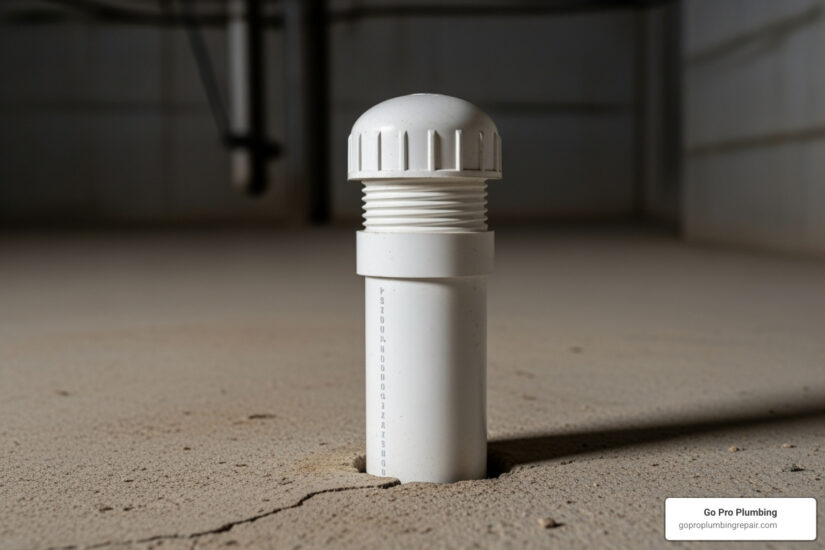
Introduction: Your Basement’s Unsung Plumbing Hero
Ever wondered about that capped pipe sticking out of your basement floor or wall? That’s your sewer cleanout in basement. It’s a critical,, part of your home’s plumbing system.
What is a sewer cleanout in basement?
- It’s a capped pipe.
- It provides direct access to your home’s main sewer line.
- It allows plumbers to clear clogs easily.
- It helps prevent messy sewage backups in your home.
This little access point can save you from big headaches and costly repairs. Understanding what it is, where to find it, and how it works is key to keeping your home’s drains flowing freely and your basement dry. Let’s dig in.
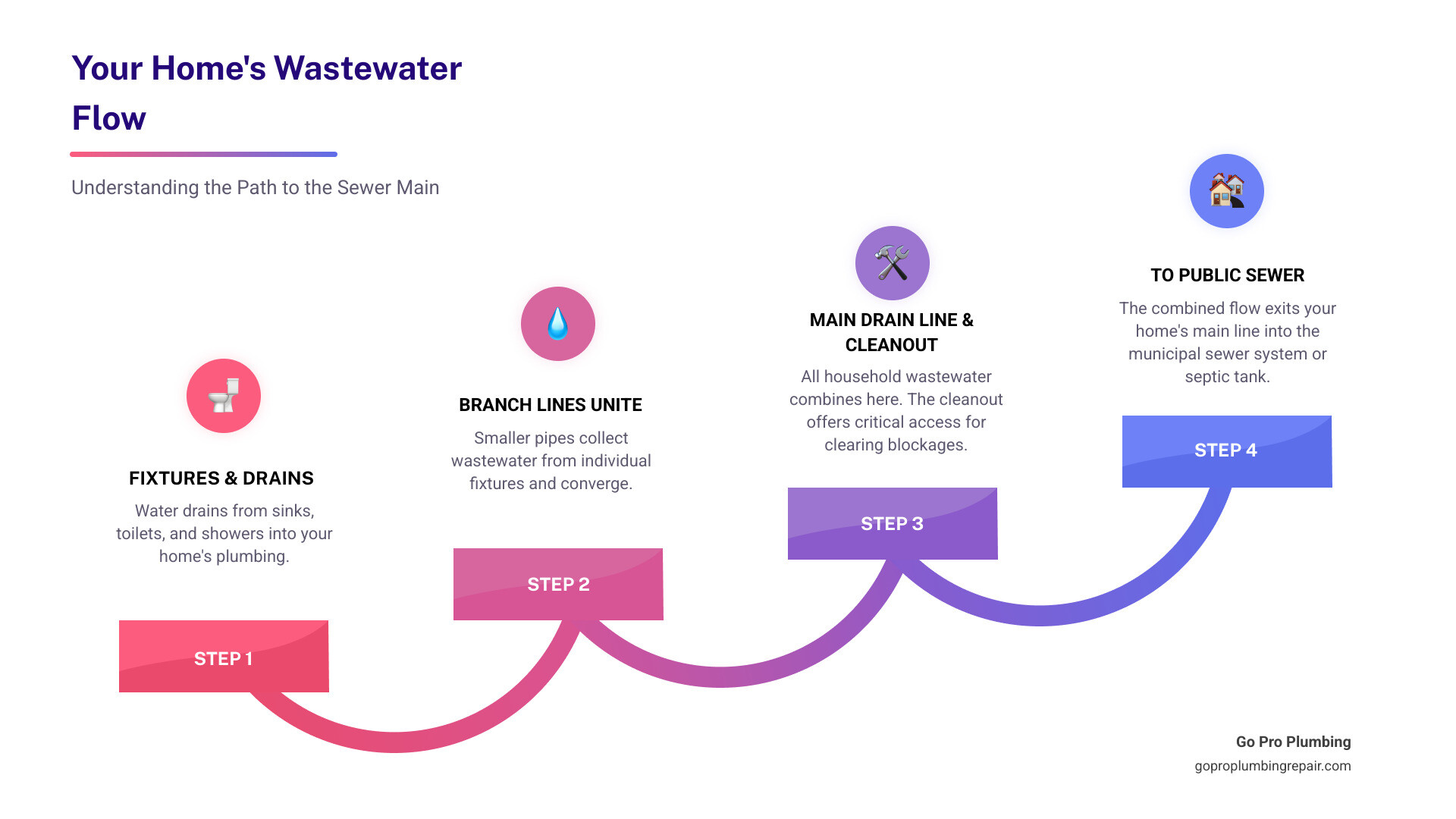
Similar topics to sewer cleanout in basement:
What is a Sewer Cleanout and Why is it Crucial for Your Basement?
Okay, let’s talk about that important pipe! Simply put, a sewer cleanout is like a special doorway into your home’s main sewer line. Imagine it as a direct access point for plumbers to get right inside your drainage system. It’s usually a capped pipe, about 3 to 6 inches wide, connecting your home’s plumbing to the city sewer or your septic tank.
This humble pipe might not look like much, but it does a huge job. It lets us inspect, maintain, and most importantly, clear out nasty clogs without having to dig up your yard or take apart your toilets!
Now, why is this so super important for your basement? Well, your basement is almost always the lowest spot in your home. So, if your main sewer line gets a blockage – you know, a real Sewer Line Blockage – gravity is going to make sure that wastewater has nowhere to go but up.
And guess where “up” often is? Right into your basement! Your basement floor drain, toilet, or shower will likely be the first to overflow. Trust us, no one wants to deal with a basement full of sewage. It causes big property damage, expensive cleanups, and is just plain awful. Having a proper sewer cleanout in basement gives us a straight shot to fix these problems fast, before a small clog turns into a major disaster.
What a Basement Sewer Cleanout Looks Like
So, what does this unsung hero look like? A typical sewer cleanout in basement often appears as a pipe, usually 4 to 6 inches wide. It’s capped with a threaded plug, which might have a square nut on top. This cap is specially made to be removed easily with a pipe wrench, giving us that important entry point.
If your home is newer, built in the last 45 years or so, you’ll probably see a cleanout made of white PVC or black ABS plastic. These materials are common and durable. But if your home is a bit older, say from before the 1970s, you might find a cleanout made of cast iron. These older ones often have a brass or cast iron plug. It’s interesting to note that about 76 million homes in America still have cast iron sewer lines!
Sometimes, your cleanout might be flush with the floor, especially in a finished basement, perhaps hidden under a small access panel. Other times, it could be a raised pipe, sticking up a few inches or even a foot or two from the floor. No matter its exact look or material, its job is always the same: to be our gateway to your main sewer line. If you’re curious to learn even more about your home’s plumbing, check out this helpful YouTube playlist.
The Importance of a Basement Access Point
Having a sewer cleanout in basement is truly a game-changer for your home’s plumbing. Its biggest perk is giving us direct access to that main sewer line. Think about it: without it, clearing a stubborn clog could mean pulling up your toilet or even going through a roof vent! That’s more time, more mess, and definitely more money.
But with a cleanout, things get much easier!
First off, it allows for easier inspections. We can use a special sewer camera to see exactly what’s causing the problem and where it is, without any guesswork. This means we can quickly pinpoint issues like tree roots or broken pipes.
Next, it leads to faster clog removal. Since we have direct access, we can use our drain augers (think of them as super long, flexible snakes) or powerful hydro-jetting equipment right where the clog is. This gets your drains flowing again much quicker, saving you hassle and disruption.
Perhaps best of all, a cleanout prevents indoor messes. If your main line backs up and the cleanout is outside, the sewage might just spill into your yard. But if you have an accessible sewer cleanout in basement, we can often deal with the problem before it turns into a catastrophic overflow inside your home. Sometimes, the cleanout itself can even act as a relief valve, letting excess water drain away and stopping your basement from flooding during big clogs or city sewer issues.
For homes with beautiful, finished basements, a cleanout is a true lifesaver. It protects your finished basement by minimizing the need for us to tear up floors or walls to reach pipes. This saves your investment and cuts down on potential repair costs.
Finally, it reduces repair costs overall. Because we can get to the problem directly and work efficiently, the time and labor needed to clear a blockage are significantly less. And less time means less money for you! That’s why having a sewer cleanout in basement means more affordable sewer and drain cleaning services. It really is a smart investment that saves you money, time, and a whole lot of stress in the long run.
Locating the Sewer Cleanout in Your Basement
Finding your sewer cleanout in basement can sometimes feel like a bit of a treasure hunt, especially if you’re new to your home or if it’s an older property. But don’t worry, knowing where to begin your search can make all the difference. Most cleanouts are strategically placed near a wall in your basement, simply because that’s where the main sewer line typically runs before it heads out of your home.
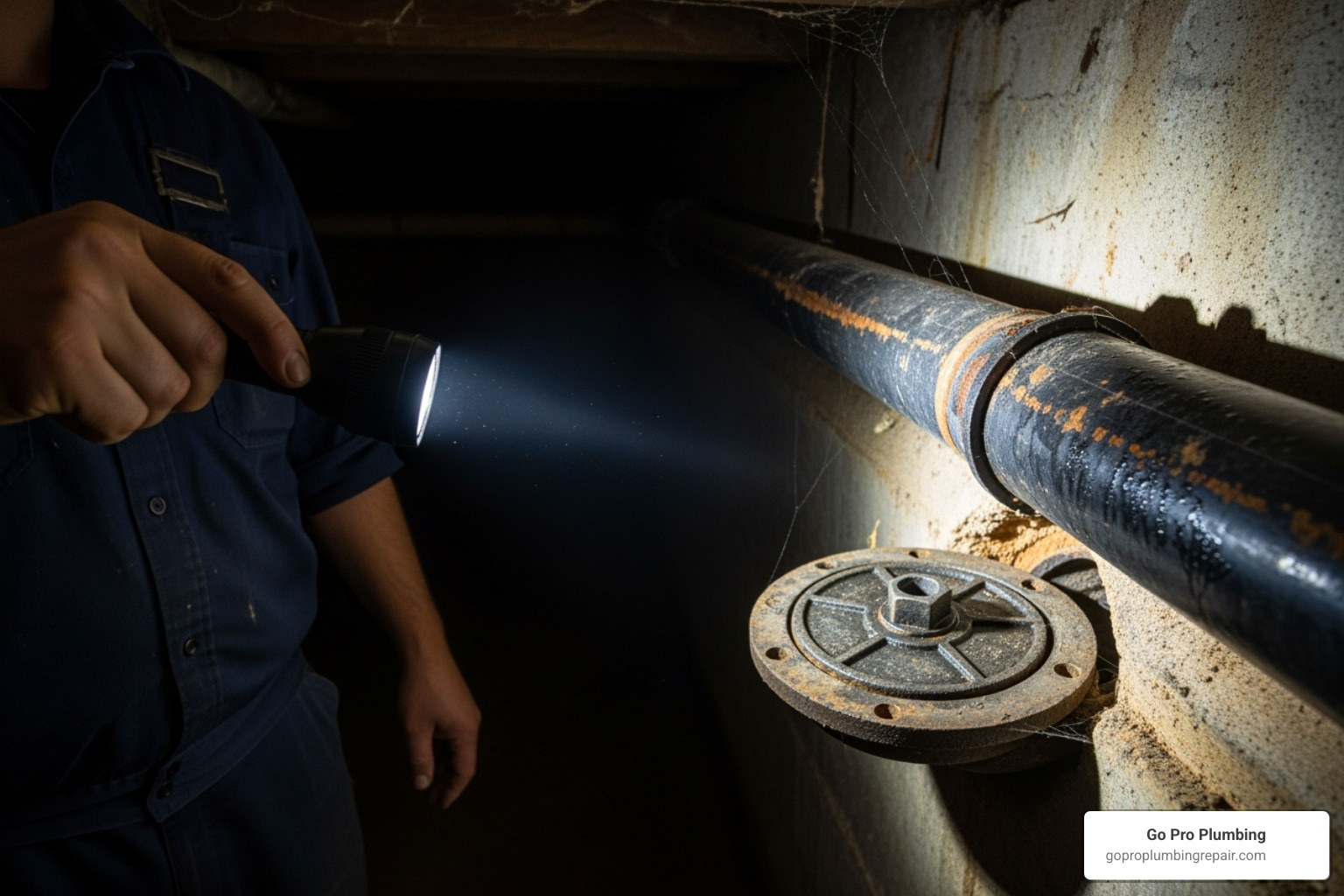
When we’re on the hunt for a sewer cleanout in basement, we usually start by checking a few common spots. You’ll often find it tucked away near the foundation wall, as that’s the main path for your sewer line. It’s also a good idea to check your utility room, often close to your water heater or furnace, where other plumbing components gather. The laundry room is another logical place, given the high volume of water used there. If your basement has a floor drain, the cleanout might be close by, since both connect to the main sewer line. Sometimes, it’s tucked away under stairs or in other less-used storage areas. The largest drainage pipe in your basement will eventually lead to the main sewer line and, ideally, to a cleanout. You might even find it near your water meter, as these lines can sometimes be in proximity.
Tips for Finding the Sewer Cleanout in Your Basement
If you’re starting on the quest to find your sewer cleanout in basement, here are our top tips to guide you:
First, try to follow the largest drain pipe in your basement. This is usually your main drain line, collecting all the wastewater from your home’s fixtures. Trace it along the basement wall or ceiling; it should eventually lead towards where it exits your house, and your cleanout might be located along this path.
Next, specifically check where the pipe exits the house. The cleanout is often located just before the main sewer line leaves your home’s foundation to connect to the municipal system or your septic tank. Also, keep an eye out for a “Y” or “T” shaped fitting where the cleanout pipe connects to the main line, with the capped pipe extending from it.
If your basement is partially or fully finished, always focus on unfinished areas first. These spots, along with utility closets or crawl spaces, usually offer easier access to plumbing lines.
When it comes to common hiding spots, remember to look along exterior walls, especially near bathrooms or laundry areas. It could also be near the main stack (that large vertical pipe that gathers all your drains). Don’t forget to check underneath or near floor drains, and within a utility closet or furnace room. In some finished basements, it might even be cleverly hidden behind a small access panel.
Challenges in Older Homes
Locating a sewer cleanout in basement can be a bit more of a puzzle in older homes, especially those built before the 1970s. Back then, cleanouts weren’t always a standard installation, or they were placed in less obvious spots. While plumbing codes evolved to make cleanouts a standard requirement from the 1940s onward, many older homes with cast iron or other non-PVC/ABS sewer lines simply didn’t feature them for maintenance.
Here are a few reasons why finding one in an older home might be tricky:
Your cleanout may be hidden. In older, renovated homes, a cleanout might have been covered up by new flooring like carpet or tile, or even drywall, during a remodeling project, making it completely invisible. More significantly, it may not exist at all. In very old homes, the only way to access the main sewer line for clearing blockages might be by removing a toilet or going through a roof vent, which can certainly increase the cost and complexity of any plumbing work.
Sometimes, if the cleanout is outdoors, it might be buried under dirt, landscaping, or even concrete, especially if it hasn’t been accessed in years. If you’re looking for an outdoor cleanout, you might need to carefully dig down an inch or so to find the cap – just be sure to always be cautious of utility lines. If you suspect it’s buried, you can find more tips on how to find a buried cleanout.
If you’ve searched high and low and still can’t locate your sewer cleanout in basement, please don’t get discouraged! This is exactly where professional help comes in handy. We have specialized tools, like advanced pipe inspection cameras, that can trace your main sewer line and pinpoint any existing cleanouts, even if they’re well-hidden. And if one doesn’t exist, we can discuss the benefits and process of installing a new one. This can bring your home up to modern plumbing standards and save you a lot of headaches (and potential mess!) down the line. Don’t hesitate to contact a professional plumber who can assist in locating it.
Warning Signs and How to Use Your Basement Sewer Cleanout
Your home’s plumbing system is pretty good at giving you a heads-up when something’s not quite right, especially with the main sewer line. Ignoring these little warnings can lead to a really messy, and often expensive, situation. But knowing these signs and understanding how your sewer cleanout in basement can be used is absolutely key for keeping your home happy and healthy.
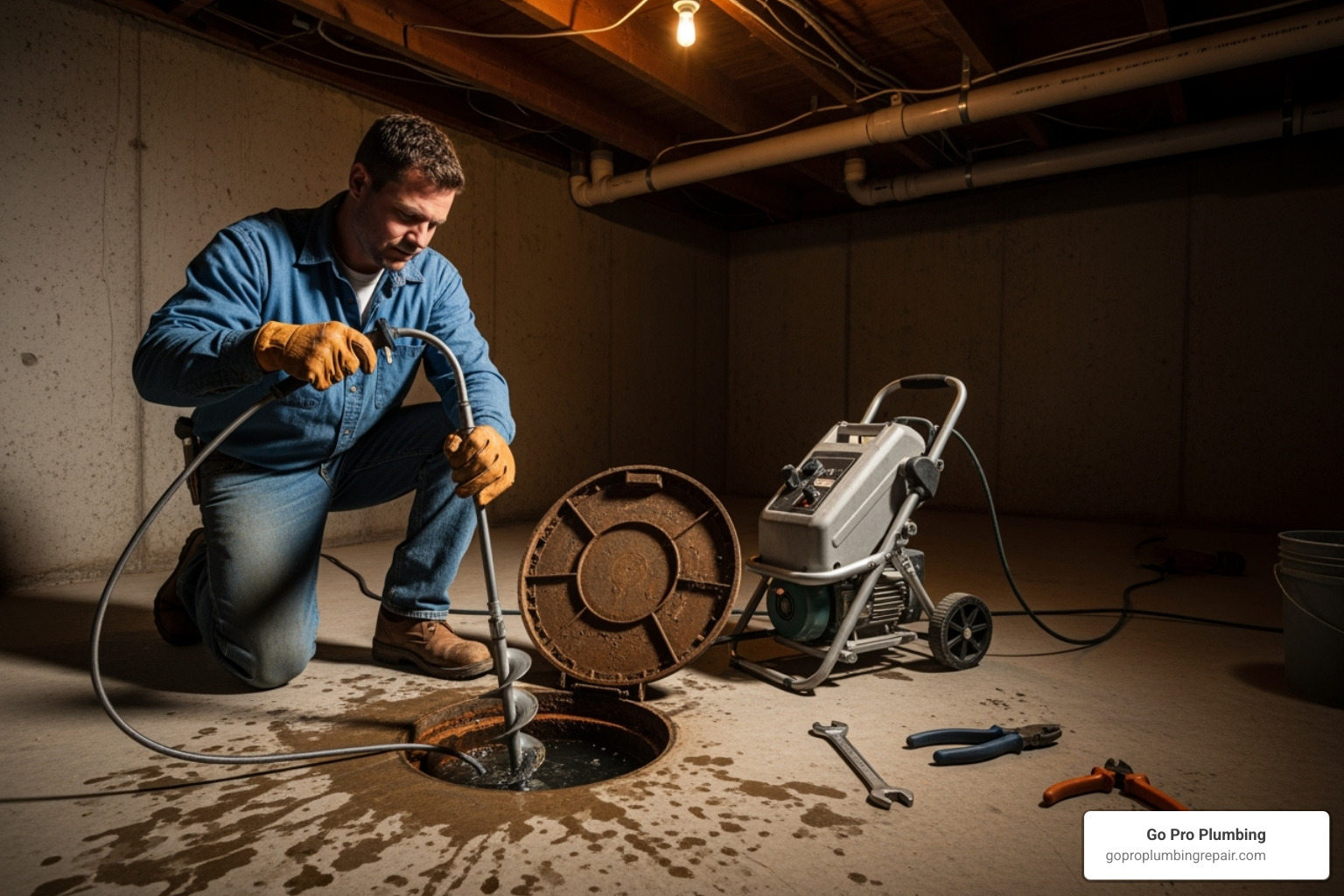
Recognizing a Main Line Problem
If you start noticing any of these symptoms, especially if they pop up at the same time or affect different fixtures around your home, it’s a pretty strong sign that your main sewer line might be clogged. And that means your sewer cleanout in basement is about to become very important!
First up, watch out for multiple slow drains. If your sinks, showers, and bathtubs throughout your home are all taking their sweet time to drain, it usually points to a blockage far beyond a single fixture. It’s likely in the main line itself. Another classic sign is gurgling noises. If you hear strange gurgling sounds coming from your toilets or other drains when water is used elsewhere in the house, that’s a big red flag. For instance, if your toilet gurgles when you run the sink, it means air is getting pulled through the toilet’s trap because of negative pressure from that main line clog. Want to learn more about what to do when your toilet gurgles? We’ve got you covered.
Then there are the foul odors. If you’re hit with persistent, unpleasant sewage smells wafting up from your drains, especially in your basement, it’s a clear indicator. It means sewer gases aren’t being properly vented and are finding their way into your home because of a blockage. And perhaps the most alarming sign is water backup in your floor drain. If flushing a toilet or running your washing machine causes water to bubble up or back up into your basement floor drain, it’s a clear sign that the main sewer line is blocked and can’t handle the incoming wastewater.
Because gravity is always at play, the lowest level fixtures back up first. This means the fixtures on the lowest level of your home (often in the basement, like a toilet or shower) will typically be the first to show signs of backup when the main line is clogged. In more severe cases, you might find yourself not being able to use the shower at all, leading to water just sitting there. And finally, the most unsettling and definite sign of a main line plumbing clog is the sight of sewage backing up in your toilets. If you experience any of these, it’s definitely time to act quickly!
Using the Sewer Cleanout in Your Basement for Clogs
Once we’ve located your sewer cleanout in basement, it becomes our go-to access point for all maintenance and clog-clearing needs. Here’s how we typically put it to good use for you:
First, we carefully open the cleanout. We gently unscrew the cap, always being cautious because there might be trapped water and gas behind it, especially if there’s an active backup. We’ll step back and let any pressure or initial spillage release safely. It’s all about safety first!
Next, we move to examining the blockage. We often use a special camera for a thorough inspection through the cleanout. This helps us pinpoint the exact location and nature of the clog – whether it’s pesky tree roots, built-up grease, foreign objects, or even a damaged pipe. Knowing what we’re up against helps us choose the best solution.
Then comes the fun part: clearing the clog. For most common clogs, we’ll insert a professional-grade drain auger (or plumbing snake) into the cleanout. This flexible cable with a cutting head can break up blockages like hair, toilet paper, or smaller roots. We maneuver it carefully to grab and pull out the obstruction. For tougher blockages, especially those caused by invasive tree roots, hardened grease, or heavy sludge, we bring out the big guns: hydro-jetting. This involves blasting water at incredibly high pressure (up to 4,000 PSI!) through the pipe. It’s super effective at scouring the insides of your sewer line and flushing out all that stubborn debris. Hydro-jetting is also fantastic for preventative maintenance. You can learn more about hydro jetter plumbing on our site.
After all that work, we always test the work. We’ll run water through your drains and main sewer line to make sure everything is flowing perfectly and that the blockage has been completely removed. And speaking of keeping things flowing, we highly recommend routine maintenance. It’s a smart move to have your sewer pipes cleaned every 18 to 24 months, even if you don’t notice any active clogs. This preventative measure, often done right through your sewer cleanout in basement, helps prevent buildup and those costly, unexpected emergencies down the line. Regular maintenance truly can save you from a lot of stress and expense. We offer comprehensive services to clean out drain pipe and ensure your system runs smoothly.
By utilizing your sewer cleanout in basement, we can efficiently diagnose and resolve your main line issues, making sure your home’s plumbing system functions exactly as it should.
No Sewer Cleanout in Basement? Safety First!
What if you’ve searched high and low, followed all our tips, and still can’t find a sewer cleanout in basement? Or maybe you know for sure your home doesn’t have one? Don’t panic! While it definitely makes accessing your main sewer line a bit trickier, it’s a common situation, especially in older homes. It just means we need to get a little more creative – and cautious – to get your drains flowing again.
What to Do if Your Basement Lacks a Cleanout
If your home doesn’t have an easily accessible sewer cleanout in basement (or anywhere else!), we do have a few alternative ways to reach your main sewer line. Often, we might need to remove a toilet. This allows us to feed our drain auger or camera directly into the main line through the toilet’s opening. It gets the job done, but it can be more disruptive and a bit messier than using a dedicated cleanout. Sometimes, for certain clogs, we can even get access through a roof vent. This involves working safely on your roof and can be a more complex process.
Now, relying on these alternatives isn’t ideal. They tend to increase the time and effort needed for drain cleaning, which can mean higher service costs for you. That’s why, if your basement lacks a cleanout, we often recommend installing a new one. Modern plumbing codes now actually require two cleanouts for all new sewer lines, showing just how important they are!
Think of installing a new cleanout as a smart investment in your home’s future. It might seem like an added expense now, but it brings long-term savings. With an easily accessible cleanout, future drain cleaning jobs become quicker, less invasive, and much more cost-effective. It’s a prime example of how being proactive with your plumbing can give you excellent value and easier maintenance down the road. We’re always happy to offer a professional assessment and discuss the benefits and process of sewer line repair or a brand new cleanout installation for your home.
Critical Safety Precautions
Working with a sewer cleanout in basement or any part of your main sewer line isn’t a job for the faint of heart – or the unprepared! There are real risks involved, mainly from exposure to raw sewage and dangerous sewer gases. This is precisely why we always stress that while it’s great to know where your cleanout is, actually opening and working on it is always best left to the professionals. We have the training, the tools, and the experience to do it safely.
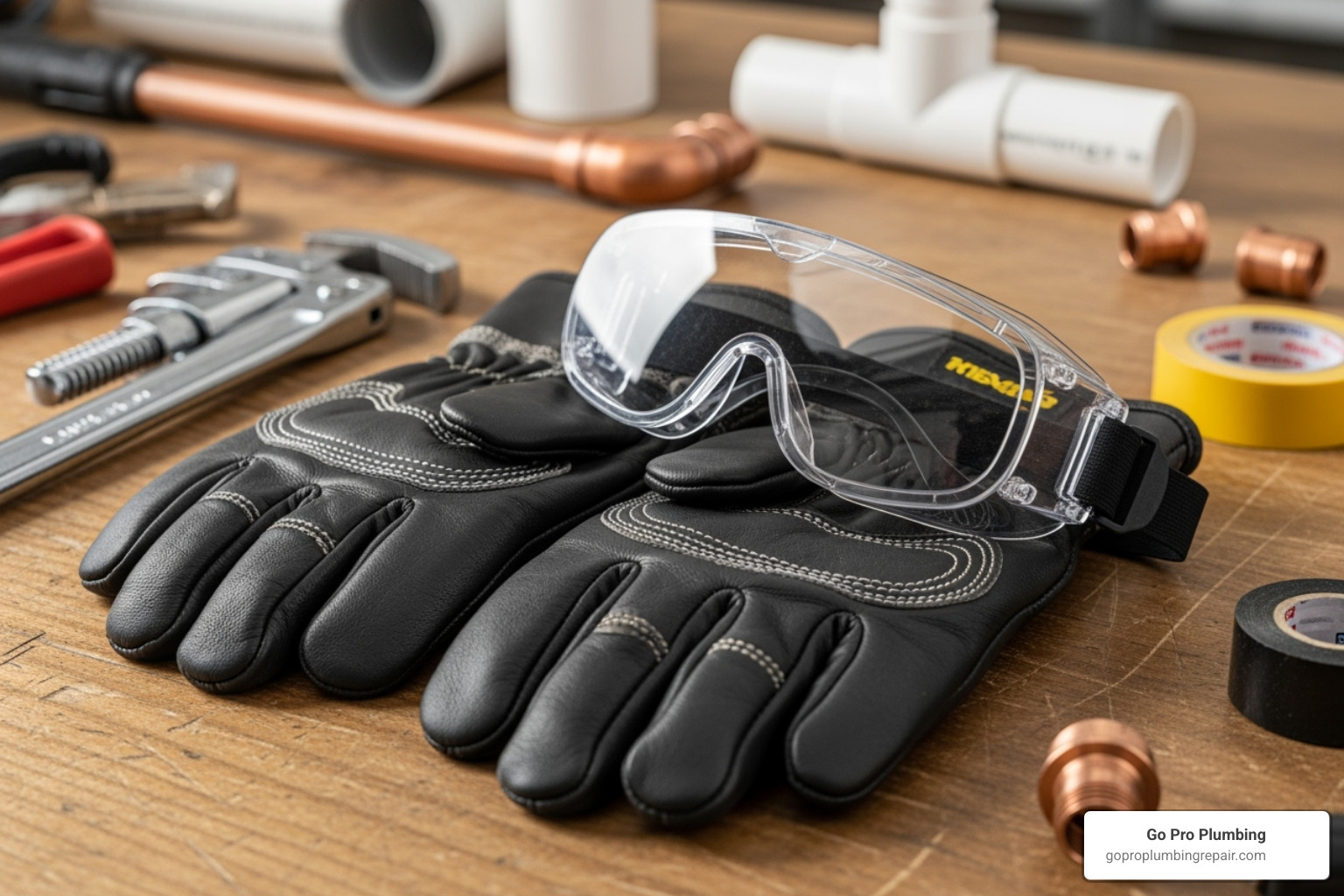
However, if you’re ever around a cleanout or observing our team at work, here are some critical safety precautions to keep in mind:
- Gear Up: Always wear heavy-duty gloves and safety goggles. Sewage is full of nasty bacteria, viruses, and other pathogens you don’t want to touch. And those goggles? They protect your eyes from splashes, which are quite common when a pressurized cleanout is opened.
- Beware of Sewer Gas: That “rotten egg” smell? That’s often hydrogen sulfide, just one component of sewer gas. It can be toxic and even flammable. Always make sure the area is well-ventilated before and during any work.
- Watch for Back Pressure: When we open a cleanout, we do it slowly and with extreme caution. A clogged main line can build up a lot of pressure, and releasing that cap too quickly can result in a powerful spray or surge of sewage. We always step back immediately after beginning to unscrew the cap to be safe.
- Prepare for a Mess: Assume there will be some spillage. Lay down plastic sheets or tarps around the cleanout and have buckets and towels ready. This helps contain any mess and makes cleanup much easier.
- When in Doubt, Call the Pros: This is the most important advice we can give: If there’s an active sewage overflow, or if you feel significant pressure or see water when you try to open the cleanout, do not proceed. Tighten the cap back down and call Go Pro Plumbing immediately. Trying to clear a major backup yourself without the right equipment or experience can lead to increased damage, personal injury, and a much larger, more expensive mess. Plus, discharging sewage improperly is harmful to the environment and illegal. We are fully equipped to handle these hazardous situations safely and effectively. For more info on what to do (and what not to do) during a sewage overflow, check out resources like this Austin Water page.
Your safety, and the safety of your home, is always our number one priority. When in doubt, always call the pros at Go Pro Plumbing!
Frequently Asked Questions about Your Basement Sewer Cleanout
Here at Go Pro Plumbing, we talk to homeowners across Northern California every day. And you know what? There are some questions we hear over and over again about that mysterious sewer cleanout in basement. We love answering them, so let’s dive into some of the most common ones!
What’s the difference between a floor drain and a sewer cleanout?
This is a fantastic question, and it’s easy to get them mixed up since they might both be found right there on your basement floor. But think of it this way: they have completely different jobs!
A floor drain is like a safety net for your basement. Its main purpose is to catch and drain away any standing water that ends up on your floor, perhaps from a leaky washing machine or a small flood. It has a special “P-trap” inside, which is a curved section of pipe that always holds a little bit of water. This water acts as a seal, blocking yucky sewer gases from sneaking into your home.
Now, a sewer cleanout in basement is totally different. It’s not there to drain water from your floor at all! Instead, it’s a sealed “secret door” that leads directly into your home’s main sewer line. Its job is to give plumbers direct access to that main pipe. We use it to clear clogs, inspect the pipes with our cameras, or do any maintenance. You should only ever see water coming out of a cleanout if we’re actively working to clear a blockage. Otherwise, it should stay sealed and dry.
Can I pour chemical drain cleaners into my sewer cleanout?
Oh, please don’t! This is one of those common ideas that can actually cause a lot more trouble than it solves. We strongly, strongly advise against pouring chemical drain cleaners into your sewer cleanout in basement or any other drain, especially if you suspect a main line clog.
Here’s why it’s a bad idea:
First, these chemical cleaners are mostly ineffective on big, tough clogs in your main sewer line. Think about it: they’re designed for little clogs like hair in a bathroom sink. They just can’t stand up to serious obstructions like stubborn tree roots, thick grease buildup, or those accidental foreign objects that often cause major backups. You’ll likely just waste your money and time.
Second, these harsh chemicals can actually damage your pipes! They can corrode older cast iron pipes over time, leading to leaks and even bigger repairs down the road. Plus, sometimes they can react with the clog itself, making it even harder and stickier, which then makes our job much tougher to clear later.
Finally, and this is a big one for us, they create a hazardous environment for our plumbers. If those chemicals don’t clear the clog, they just sit there in the pipe. When we eventually open the cleanout to do the job properly, we’re exposed to those dangerous, toxic chemicals.
For real main line clogs, you need professional solutions like snaking (with a drain auger) or powerful hydro-jetting. These methods physically remove the obstruction safely, without harming your plumbing system or creating risks for anyone involved.
What should I do if the cap on my basement cleanout is stuck or broken?
This is a really common issue, especially if you have an older sewer cleanout in basement with a metal cap. Over time, those caps can corrode and get stuck tight. While a big pipe wrench might seem like the answer, trying to force a stuck cap can be risky. You could end up breaking an older, brittle pipe, turning a simple problem into a much larger, more expensive repair. Trust us, that’s not fun for anyone!
If you find that your cleanout cap is stuck, damaged, or even missing entirely, it’s definitely time to call in the professionals. A missing or broken cap isn’t just an inconvenience; it means your main sewer line is open right there in your basement. This allows hazardous sewer gases (which smell terrible, are potentially flammable, and can be harmful to breathe) to waft into your home. It also creates a direct pathway for unwanted pests to enter your house.
Our team has the right tools and expertise to safely remove stuck caps without damaging your pipes. We can also repair or replace damaged ones, and make sure you have a proper, airtight seal. This helps keep those nasty sewer gases out and protects your home. If needed, we’re even equipped for full sewer line replacement of the plug itself. Your safety and peace of mind are always our priority!
Conclusion: Keep Your Drains Flowing and Your Basement Dry
So, there you have it! That humble pipe, your sewer cleanout in basement, really is a silent guardian of your home. It might not be the flashiest part of your house, but understanding its role is a true game-changer for keeping your plumbing happy. Knowing what it’s for, where it hides, and what signals it sends can save you from a world of trouble.
This knowledge empowers you to be proactive. You can prevent those dreaded, costly sewer backups and avoid the messy aftermath, like having to go through cleaning basement after sewer backup. It helps ensure your entire plumbing system hums along smoothly for many years to come.
For our wonderful homeowners right here in Northern California, we at Go Pro Plumbing are always ready to lend a hand. We pride ourselves on delivering outstanding customer service and those crucial same-day solutions you need. Whether you’re struggling to locate a hidden sewer cleanout in basement, battling a stubborn main line clog, or thinking about installing a brand-new cleanout to better protect your home, our friendly and expert team is just a call away. Why wait for a plumbing emergency to strike? A little preventative care now can really go a long way in saving you stress and money later.
Ready to make sure your plumbing is in tip-top shape? For expert help with your sewer cleanout in basement or any other plumbing issue, don’t hesitate to explore our professional Drain & Sewer Services. We’re genuinely here to keep your drains flowing freely and your basement wonderfully dry!
